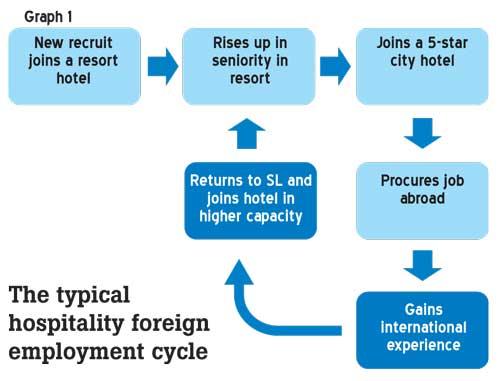
Much has been talked about and discussed about Sri Lanka’s tourism boom and the impending human resource shortfall that the industry will have to face.
Although detailed numbers and assessments are difficult to be derived accurately due to the lack of proper information, the World Travel and Tourism Council Sri Lanka Country Report 2017 reports that the tourism and hospitality industry in Sri Lanka generated 404,000 jobs directly and indirectly (5.1 percent of total employment) (5.3 percent of total employment). This includes employment by hotels, travel agents, airlines and other passenger transportation services.
When discussing tourism employment in Sri Lanka, one aspect that often crops up is about the exodus of well-trained hospitality staff abroad, particularly to the Middle East and Maldives. This led to considerable discussion. Hence, it was felt that this would be an opportune moment to discuss this issue in greater detail in a monograph.
Sri Lankan labour force
Local general employment
It is a well-known fact that Sri Lanka has a high literacy rate of 95 percent (Higher Education Ministry) with a labour force of 8,249,773 over the age of 18 years (Census and Statistics Department 2016). The unemployment rate is about 4.5 percent.
“The number of women participating in Sri Lanka’s workforce has declined to 36 percent in 2016, from 41 percent in 2010,” according to the World Bank.
This is very much lower than the world average of 54 percent (World Bank: Labour force female participation rate 2016). In Asian nations, this could be due to marriage, childrearing and related household chores and gender discrimination.
Foreign employment
Remittances of Sri Lankans working abroad have assumed a great importance to the Sri Lankan economy. Today, worker remittances have become Sri Lanka’s largest foreign exchange earner and the country’s balance of payment has been highly dependent on the income generated by migrant employees.
According to the Central Bank, the earnings from tourism recorded a healthy growth of 11.6 percent with earnings rising to US $ 4,381 million in 2018, against US $ 3,925 million in 2017. On the contrary, the workers’ remittances recorded a decline of 2.1 percent to US $ 7,015 million in 2018, from US $ 7,164 million in 2017.
Even though there is a decline seen, the significance of remittances to Sri Lanka’s balance of payments and the economy is of such a magnitude that some have described the contemporary Sri Lankan economy as a ‘remittance-dependent economy’. There is an average ‘outflow’ per year of about 260,000 Sri Lankans, of which 66 percent are males. Housemaids amount to about 26 percent. (Sri Lanka Bureau of Foreign Employment – SLBFE 2017)
Local tourism employment
Tourism is considered to be one of the foremost industries that provides a wide range of employment opportunities for young people
According to the SLTDA Country Report 2Q 2019, there are about 39,525 hotel rooms in the formal (registered) sector in operation, in 2,469 establishments. In addition, it is estimated that 382 units are the ‘pipeline’, which will add a further 19,218 rooms in the next few years.
This author has estimated that the new staff required to service this total estimated room stock of 58,743 will be about 120,000 only in the direct/formal sector). Taking into consideration the multiplier effect of the informal sector, this total requirement could then swell to more than 250,000, resulting in a total estimated workforce in tourism of about 600,000 or more by 2020.
This would then mean that about 8 percent of the Sri Lankan labour force would be engaged in tourism by 2020.
Local tourism employees in foreign employment
It is a well-known fact that a large number of Sri Lankan skilled hospitality employees are employed in the Middle East and Maldives. However, there are no credible statistics of these numbers available.
Hence, some conservative assumptions will be made as follows, to estimate these numbers.
-The total estimated Sri Lankan workforce abroad - 1,189,359.
-Percentage of housemaids (ref. SLFBE) - 26 percent.
-Assume that 12 percent of the non-housemaid category is tourism-related jobs.
-Hence, on this basis, the estimated breakdown will be as in Table 1.
-This analysis indicates that some 140,000 Sri Lankan tourism employees could be employed
in foreign countries.
-According to the SLFEB, on average, 260,000 employees leave for foreign employment each year.
-If the same ratio as above is applied, then it would mean that the annual attrition or ‘outflow’ of tourism employees each year would be about 30,000.
Issue
From the forgoing basic analysis, it is seen that some 404,000 tourism employees are employed in the country, while the industry effectively ‘looses’ about 30,000 employees each year. (approx. 7-8 percent)
The issue at hand therefore, is whether this is a good thing or bad.
At first glance, it appears that Sri Lanka is losing its skilled tourism staff to establishments abroad, which is effectively a ‘brain drain’.
However, closer study of this phenomenon reveals a slightly different picture.
Step 1: As most tourism practitioners know, in the hotel industry in Sri Lanka, very often, raw untrained young people join a resort to start their working career in hospitality. They start from the bottom rungs, gain experience and work their way up the hierarchy in their chosen department or field. Even the basics of grooming and etiquette are instilled in the resort environment. Therefore, most good resort hotels are really the basic training grounds for young aspiring hoteliers.
Step 2: After some years of gaining experience, the recruit rises up the ranks in the resort to higher positions of employment. (See Graph 1)
Step 3: Eventually the individual may leave the resort to work in a five-star city hotel, to gain more experience and knowledge. Most often it is a young person’s dream to work in a star-class city hotel, which gives him a wider exposure of the industry.
Step 4: After some years of work in the five-star city hotel, the young aspirant may look for employment abroad. Good pay, accommodation facilities, air tickets and other benefits lure these young men and women abroad on contractual employment. Most international hotel brands operating in the Middle East and Maldives look for staff having good experience in a five-star environment. So, it is not an unusual phenomenon to see a steady exodus of trained personnel to foreign lands to work there.
Step 5: In a good foreign hospitality working environment, especially with international brands, there is a high level exposure to good practices and experience, most often working in close contact with world-renowned experts in the respective fields. In this manner the young person gains a wealth of knowledge and experience while being well remunerated for his services.
Step 6: Most such foreign employment is on a fixed term contract, possibly renewable over a few cycles. Eventually the employee earns sufficient money for his living back home in Sri Lanka and decides to come back. When he returns with his new experience and knowledge under his belt, most hotels in the city or resorts would very easily recruit him, at a much higher position than before he left.
Thus, the cycle is closed with the young employee now in a higher position, both at work and society, with some reasonable savings in the bank to look after his family.
Conclusion
From the foregoing analysis and evaluation, it clear that in the case of the tourism industry, the exodus of employees going abroad, may not altogether be a bad thing for the industry. Staff who go abroad come back more skilled and experienced at the end of their
contract abroad.
Hence, it may not be all doom and gloom for the hotel industry due to employees leaving Sri Lanka for enjoyment abroad. Quite apart from considering it a ‘brain drain’, perhaps the hospitality industry should consider this as
a ‘brain gain’.
(References: Sri Lanka Annual Labour Force Survey 2016 - Census and Statistics Department, National Policies and Economic Affairs Ministry; Sri Lanka Bureau of Foreign Employment - corporate plan 2017-2021; Sri Lanka Tourism Development Agency Country
Report 2Q 2019)
(Srilal Miththapala, an electrical engineer by profession, is a senior personality in the country’s tourism industry and is a past President of the Tourist Hotels Association of Sri Lanka. He can be contacted via srilal.mith@gmail.com)

 Much has been talked about and discussed about Sri Lanka’s tourism boom and the impending human resource shortfall that the industry will have to face.
Much has been talked about and discussed about Sri Lanka’s tourism boom and the impending human resource shortfall that the industry will have to face. 



